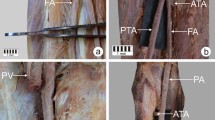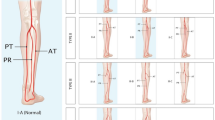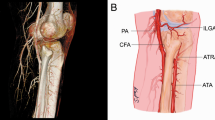Summary
A well-documented case of absence of the posterior tibial a. is reported. We have studied 40 personal case-records of dissection of the arteries of the leg in fresh corpses. This study allowed classification of the origins of the leg arteries from the popliteal a. into 7 groups. Several findings emerged: 1) the peroneal a. is constant, for phylogenetic and embryologic reasons, 2) the posterior tibial a. is absent in 1 to 5% of cases [1, 2, 4, 6–8] (Fig. 4), in which case the vascularisation of the fibula remains as normal (the proximal epiphysis of the fibula is vascularised by the anterior tibial a., the diaphysis and the distal epiphysis by the peroneal a.). Other anatomic variations may be found: trifurcation of the popliteal a., origin of the anterior tibial a. from the peroneal a., absence of the anterior tibial a., aplasia of the terminal portions of both the anterior and posterior tibial aa. In practice, absence of the posterior tibial a. can be demonstrated by arteriography and doppler ultrasound. We are dubious about the indications for arteriography, which is not always a risk-free examination, and therefore prefer doppler examination with ultrasound, which supplies adequate information in the majority of cases.
Réumé
Ce travail concerne un cas bien documenté d'absence d'a. tibiale postérieure et une étude analytique de 40 dissections des artères de jambe sur sujets frais. Cette analyse a permis de classifier l'origine des artères de jambe à partir de l'a. poplitée en 7 groupes. Plusieurs déductions ont été faites : l'a. fibulaire est constante pour des raisons phylogèniques et embryologiques; l'a. tibiale postérieure est absente dans l à 5 % des cas [1, 2, 4, 6–8] (Fig. 4), et dans ce cas la vascularisation de la fibula demeure inchangée (l'épiphyse proximale de la fibula est vascularisée par l'a. tibiale antérieure, la diaphyse et l'épiphyse distale sont vascularisées par l'a. fibulaire). D'autres variations anatomiques peuvent se rencontrer : trifurcation de l'a. poplitée ; origine de l'a. tibiale antérieure à partir de l'a. fibulaire ; absence d'a. tibiale antérieure ; aplasie de la partie terminale des deux aa. tibiales antérieure et postérieure. En pratique, l'absence d'a. tibiale postérieure peut être affirmée par l'artériographie et l'échographie doppler. L'indication de l'artériographie qui n'est pas un examen anodin doit être nuancée, les auteurs préfèrent pour cette raison le doppler avec échographie doppler qui apporte des éléments suffisants dans la majorité des cas.
Similar content being viewed by others
References
Adachi B (1928) Das Arteriensystem der Japaner, vol 2. Kenkyusha, Kyoto, pp 197–241
Bastide F, Lefebvre D (1991) Les artères de la jambe. In: Bonnel F, Chevrel JP, Outrequin G (eds) Anatomie Clinique — Les Membres. Springer-Verlag, Paris Heidelberg New York, pp 479–485
De Vriese B (1902) Recherche sur l'évolution des vaisseaux sanguins des membres chez l'homme. Arch Biol 18: 665–720
Dubreuil-Chambardel L (1925) Variation des artères du pelvis et du membre inférieur. Masson, Paris, pp 240–247
Germain MA, Gomez NG, Demers G, Hureau J (1993) Bases anatomiques de la reconstruction de la mandibule par transfert libre composé de fibula. Surg Rad Anat 15: 213–214
Kamina P, Di Marino V (1988) Anatomie: introduction à la clinique ; vaisseaux des membres. Maloine, Paris, pp 133–140
Keen JA (1961) A study of the arterial variation in the limbs, with a special reference to symmetry of vascular patterns. Am J Anat 108: 245–261
Lippert H, Pabst R (1985) Arterial variation in man, classification and frequency. Bergman, München, pp 60–64
Senior HD (1919) On the development of the arteries of the human lower extremity. Am J Anat 25: 55–97
Author information
Authors and Affiliations
Rights and permissions
About this article
Cite this article
Piral, T., Germain, M. & Princ, G. Absence of the posterior tibial artery: implications for free transplants of the fibula. Surg Radiol Anat 18, 155–158 (1996). https://doi.org/10.1007/BF01795242
Received:
Accepted:
Issue Date:
DOI: https://doi.org/10.1007/BF01795242




